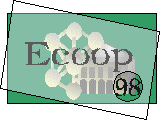
12th European Conference on Object-Oriented Programming
Brussels, Belgium, July 20 - 24, 1998
 |
12th European Conference on Object-Oriented Programming |
Tutorial T8 |
| Organizers: |
Cristina Videira Lopes
Xerox PARC Gregor Kiczales Xerox PARC |
| Day: | Monday afternoon |
| Level: | Intermediate |
| Room: | C403 (5th floor) |
AspectJ(TM) is an aspect-oriented extension to Java(TM) that helps achieve improved separation of concerns in concurrent and/or distributed Java applications, thereby helping to simplify code development and maintenance. AspectJ separates the implementation of functionality from issues of synchronization and distribution. In AspectJ there are three kinds of modules: (1) classes, which are used to implement system functionality; (2) coordinators, which are used to program control of thread synchronization; and (3) portals which are used to control data and computation movement in remote method invocations.
This tutorial shows how to program distributed and/or concurrent applications using aspect-oriented programming and AspectJ. Additionally, we will present an overview of the implementation of AspectJ's weaver, with an eye to providing a general grounding in AOP.
Dr. Cristina Videira Lopes is a scientist at the Xerox Palo Alto Research Center. Her research interests are in software engineering and programming languages. She has been developing aspect-oriented programming languages, in particular for distributed applications.
Gregor Kiczales is a principal scientist at the Xerox Palo Alto Research Center. His interests are in software engineering, programming languages and software architecture. His current focus is on the development of aspect-oriented programming. He has been an invited speaker at both ECOOP and OOPSLA conferences. He is a co-author of the book "The Art of the Metaobject Protocol".